Zillow warns that sea level rise could inundate 1.9 million U.S. homes
 One of the more impactful films screened by Eric Raddatz and Melissa DeHaven at the Sixth Annual Fort Myers Film Festival this past April was Josh Fox’s documentary How to Let Go of the World and Love All the Things Climate Can’t Change. In the documentary, Fox visits 12 countries on six continents to assess the impact of climate change and survey how the planet’s growing number of climate refugees are coping with environmental grief.
One of the more impactful films screened by Eric Raddatz and Melissa DeHaven at the Sixth Annual Fort Myers Film Festival this past April was Josh Fox’s documentary How to Let Go of the World and Love All the Things Climate Can’t Change. In the documentary, Fox visits 12 countries on six continents to assess the impact of climate change and survey how the planet’s growing number of climate refugees are coping with environmental grief.
Since the Fort Myers Film Festival’s closing on April 10, the world has been witnessing the inexorable loss of land and habitat to sea level rise, just as Fox predicted in the documentary. In late April, the world learned that five tiny islands in the Soloman 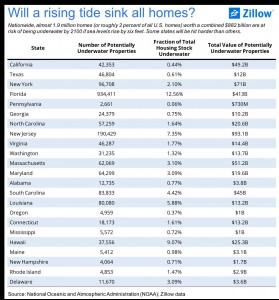 Archipelago have disappeared amid rising seas and erosion. In June, UNESCO warned that projected sea level rise threatens more than a dozen World Heritage sites including Venice, Italy, the Sydney Opera House, the Galapagos Islands, Stonehenge, Easter Island and the Statue of Liberty. And now, real estate data firm Zillow warns that the United States alone could lose more than 1.9 million homes if sea levels rise by the six feet projected by climatologists if carbon dioxide emissions continue unabated.
Archipelago have disappeared amid rising seas and erosion. In June, UNESCO warned that projected sea level rise threatens more than a dozen World Heritage sites including Venice, Italy, the Sydney Opera House, the Galapagos Islands, Stonehenge, Easter Island and the Statue of Liberty. And now, real estate data firm Zillow warns that the United States alone could lose more than 1.9 million homes if sea levels rise by the six feet projected by climatologists if carbon dioxide emissions continue unabated.
The Paris Accord could result in a reduction of 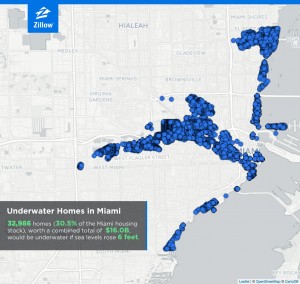 greenhouse gases. And sea walls, barriers and other flood-prevention efforts could help minimize the risk of sea level rise in some areas. But notwithstanding these initiatives, sea levels are going to rise. Insurance companies are anticipating it. Many cities are planning for it.
greenhouse gases. And sea walls, barriers and other flood-prevention efforts could help minimize the risk of sea level rise in some areas. But notwithstanding these initiatives, sea levels are going to rise. Insurance companies are anticipating it. Many cities are planning for it.
“This is going to be a massive issue worldwide,” Michael Gerrard of Columbia University, who directs the Sabin Center for Climate Change Law, told The Washington Post’s Brady Dennis in a 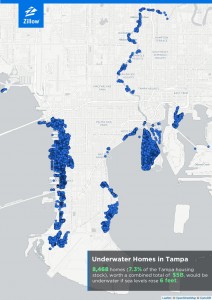 recent interview. “We don’t know yet the exact pace, but we know it’s coming. A certain amount is unavoidable.”
recent interview. “We don’t know yet the exact pace, but we know it’s coming. A certain amount is unavoidable.”
Using maps released by the National Oceanic and Atmospheric Administration to determine what coastal areas would be inundated, Zillow then consulted its nationwide database to determine which properties were most at risk of being flooded — at least on the ground level — by the next century. And the state most at risk is Florida, which would account for 934,411 of the 1.9 million homes that could be lost to sea level rise. Miami could lose nearly a third of its housing, though Miami Beach already is spending hundreds of millions of dollars to install pumps and raise sea walls and roads in a 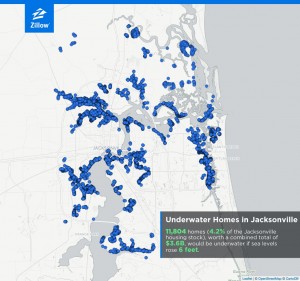 bid to stave off encroaching water. The situation is equally dire in Jacksonville, Tampa and Fort Myers. (Other states at high risk include New Jersey (with 190,429 homes), South Carolina (with 83,833 homes) and Louisiana (with 80,080 homes). Cities in danger include Boston (where one in five homes could be inundated),Honolulu (one in four homes), Virginia Beach, San Diego, Long Beach, Seattle and New York.)
bid to stave off encroaching water. The situation is equally dire in Jacksonville, Tampa and Fort Myers. (Other states at high risk include New Jersey (with 190,429 homes), South Carolina (with 83,833 homes) and Louisiana (with 80,080 homes). Cities in danger include Boston (where one in five homes could be inundated),Honolulu (one in four homes), Virginia Beach, San Diego, Long Beach, Seattle and New York.)
“It’s important to note that 2100 is a long way off, 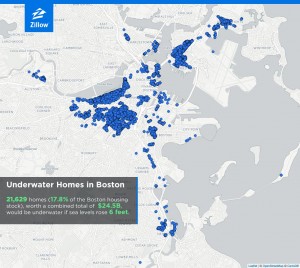 and it’s certainly possible that communities take steps to mitigate these risks,” states Zillow. “Then again, given the enduring popularity of living near the sea despite its many dangers and drawbacks, it may be that even more homes will be located closer to the water in a century’s time, and these estimates could turn out to be very conservative. Either way, left unchecked, it is clear the threats posed by climate change and rising sea levels have the potential to destroy housing values on an
and it’s certainly possible that communities take steps to mitigate these risks,” states Zillow. “Then again, given the enduring popularity of living near the sea despite its many dangers and drawbacks, it may be that even more homes will be located closer to the water in a century’s time, and these estimates could turn out to be very conservative. Either way, left unchecked, it is clear the threats posed by climate change and rising sea levels have the potential to destroy housing values on an 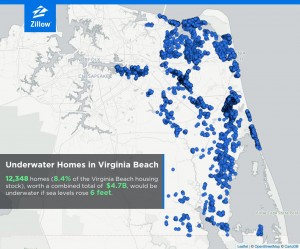 enormous scale.”
enormous scale.”
Posted August 25, 2016
Related Articles.
- Skype Q&A with Filmmaker Josh Fox
- Five Pacific islands lost to sea level rise
- United Nations warns that rising sea levels threaten Statue of Liberty
- Josh Fox documentary airs on HBO June 27 and
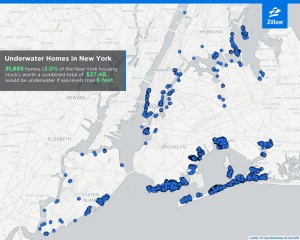 all summer long
all summer long - Louisiana’s Isle de Jean Charles losing battle to sea level rise
- Residents of Barrow, Alaska on verge of becoming ‘climate refugees’














 Tom Hall is both an amateur artist and aspiring novelist who writes art quest thrillers. He is in the final stages of completing his debut novel titled "Art Detective," a story that fictionalizes the discovery of the fabled billion-dollar Impressionist collection of Parisian art dealer Josse Bernheim-Jeune, thought by many to have perished during World War II when the collection's hiding place, Castle de Rastignac in southern France, was destroyed by the Wehrmacht in reprisal for attacks made by members of the Resistance operating in the area. A former tax attorney, Tom holds a bachelor's degree as well as both a juris doctorate and masters of laws in taxation from the University of Florida. Tom lives in Estero, Florida with his fiancee, Connie, and their four cats.
Tom Hall is both an amateur artist and aspiring novelist who writes art quest thrillers. He is in the final stages of completing his debut novel titled "Art Detective," a story that fictionalizes the discovery of the fabled billion-dollar Impressionist collection of Parisian art dealer Josse Bernheim-Jeune, thought by many to have perished during World War II when the collection's hiding place, Castle de Rastignac in southern France, was destroyed by the Wehrmacht in reprisal for attacks made by members of the Resistance operating in the area. A former tax attorney, Tom holds a bachelor's degree as well as both a juris doctorate and masters of laws in taxation from the University of Florida. Tom lives in Estero, Florida with his fiancee, Connie, and their four cats.